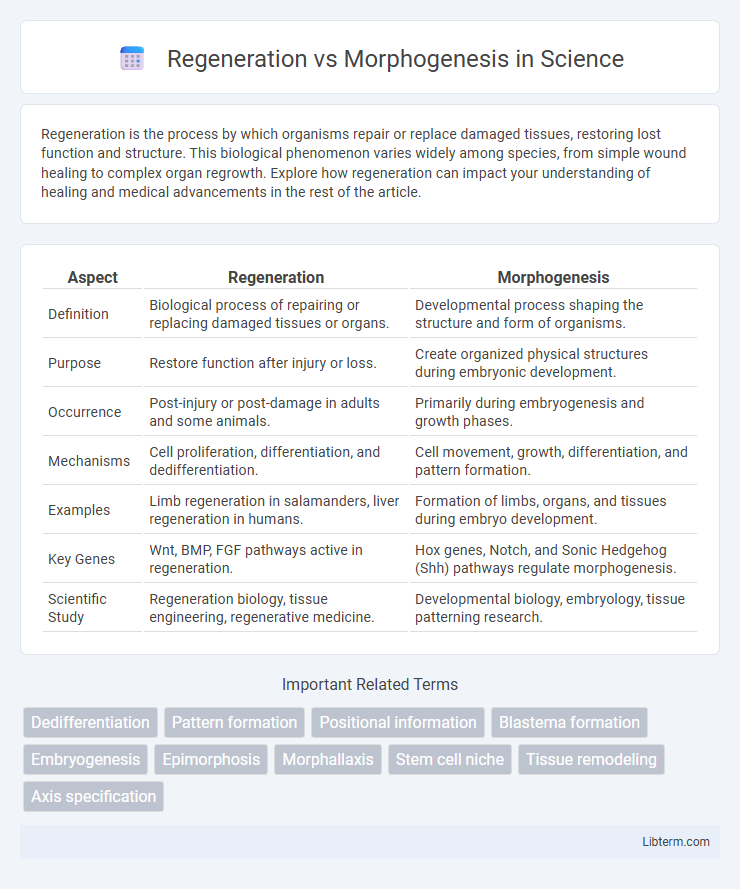Regeneration is the process by which organisms repair or replace damaged tissues, restoring lost function and structure. This biological phenomenon varies widely among species, from simple wound healing to complex organ regrowth. Explore how regeneration can impact your understanding of healing and medical advancements in the rest of the article.
Table of Comparison
| Aspect | Regeneration | Morphogenesis |
|---|---|---|
| Definition | Biological process of repairing or replacing damaged tissues or organs. | Developmental process shaping the structure and form of organisms. |
| Purpose | Restore function after injury or loss. | Create organized physical structures during embryonic development. |
| Occurrence | Post-injury or post-damage in adults and some animals. | Primarily during embryogenesis and growth phases. |
| Mechanisms | Cell proliferation, differentiation, and dedifferentiation. | Cell movement, growth, differentiation, and pattern formation. |
| Examples | Limb regeneration in salamanders, liver regeneration in humans. | Formation of limbs, organs, and tissues during embryo development. |
| Key Genes | Wnt, BMP, FGF pathways active in regeneration. | Hox genes, Notch, and Sonic Hedgehog (Shh) pathways regulate morphogenesis. |
| Scientific Study | Regeneration biology, tissue engineering, regenerative medicine. | Developmental biology, embryology, tissue patterning research. |
Introduction to Regeneration and Morphogenesis
Regeneration involves the biological process by which organisms replace or restore damaged tissues or lost body parts, crucial for healing and survival in many species. Morphogenesis refers to the developmental process that governs the shape and structure formation of tissues and organs during embryonic growth. Understanding the distinct cellular mechanisms and molecular pathways driving regeneration and morphogenesis provides insights into tissue engineering and regenerative medicine.
Defining Regeneration: Concepts and Scope
Regeneration refers to the biological process by which organisms restore or replace damaged or lost tissues, organs, or limbs, ensuring functional recovery and survival. It encompasses various mechanisms such as cell proliferation, differentiation, and pattern formation, distinguishing it from morphogenesis, which primarily involves the initial development of form and structure during embryogenesis. The scope of regeneration includes both epimorphosis--where new structures form through cell division--and morphallaxis, characterized by the reorganization of existing cells without significant proliferation.
Understanding Morphogenesis: Key Principles
Morphogenesis involves the biological processes that control the shape and structure of tissues and organs through cell differentiation, spatial distribution, and pattern formation guided by genetic and biochemical signals. It relies on mechanisms such as differential gene expression, cell migration, and mechanical forces to establish the architecture of an organism during development. Understanding morphogenesis is crucial for insights into developmental biology, congenital anomalies, and tissue engineering applications.
Cellular and Molecular Mechanisms
Regeneration and morphogenesis involve distinct yet overlapping cellular and molecular mechanisms where regeneration primarily activates stem cells and dedifferentiation pathways to replace damaged tissues through proliferative signaling cascades like Wnt, Notch, and BMP. Morphogenesis orchestrates spatial organization and tissue patterning via gradients of morphogens such as Sonic Hedgehog (Shh) and Fibroblast Growth Factors (FGFs), regulating cell migration, differentiation, and apoptosis during embryonic development. Both processes depend heavily on dynamic cytoskeletal rearrangements, extracellular matrix remodeling, and gene regulatory networks controlled by transcription factors like Sox, Pax, and Hox genes to ensure precise tissue architecture.
Comparative Analysis: Regeneration vs Morphogenesis
Regeneration involves the restoration of lost or damaged tissues through cellular proliferation and differentiation, enabling organisms to recover structural and functional integrity. Morphogenesis refers to the biological process that controls the shape and structure development of tissues and organs during embryogenesis and growth. Comparative analysis reveals that while regeneration recapitulates aspects of morphogenesis, it is distinct by its context-driven activation in mature tissues, highlighting unique signaling pathways and gene expression profiles.
Role of Stem Cells in Regeneration
Stem cells play a crucial role in regeneration by differentiating into various cell types needed to replace damaged tissues, unlike morphogenesis, which primarily involves the spatial organization and pattern formation during embryonic development. In regenerative processes, adult stem cells activate proliferative pathways to restore tissue structure and function, ensuring repair and homeostasis. Their unique capacity for self-renewal and multipotency distinguishes regeneration as a dynamic system of cellular replenishment rather than the initial developmental blueprint established during morphogenesis.
Genetic Regulation in Morphogenesis
Genetic regulation in morphogenesis involves a complex interplay of signaling pathways and gene expression patterns that dictate the spatial and temporal development of tissues and organs. Key genes such as Hox, Pax, and Wnt families orchestrate cell differentiation, proliferation, and pattern formation essential for shaping the organism. Unlike regeneration, which primarily activates repair mechanisms, morphogenesis relies on tightly controlled genetic networks to establish the body plan during embryonic development.
Evolutionary Perspectives
Regeneration and morphogenesis are distinct yet interconnected biological processes shaped by evolutionary pressures to maintain organismal integrity and adaptability. Regeneration involves the restoration of lost or damaged tissues, often reflecting an organism's capacity to recover from injury, which varies widely across species due to evolutionary trade-offs. Morphogenesis, the developmental process that dictates the shape and structure of organisms, has evolved through natural selection to optimize functional anatomy and reproductive success across diverse taxa.
Applications in Medicine and Biotechnology
Regeneration involves the natural process of restoring damaged tissues or organs, while morphogenesis governs the development of an organism's shape and structure through cell differentiation and spatial organization. In medicine, harnessing regeneration techniques enables advanced therapies for wound healing, organ repair, and stem cell treatments, whereas morphogenesis insights drive tissue engineering and organ-on-chip models that replicate complex anatomical structures. Biotechnology applications increasingly leverage both processes to develop regenerative medicine, improve drug testing platforms, and innovate synthetic biology approaches for tissue fabrication.
Future Directions and Research Challenges
Future directions in regeneration and morphogenesis research emphasize advancing bioengineering techniques to replicate complex tissue structures and improve functional integration of regenerated tissues. Challenges persist in understanding cellular signaling pathways and genetic regulation that govern precise spatial and temporal control during morphogenetic processes. Cutting-edge approaches like single-cell genomics and CRISPR-based gene editing aim to decode intricate cell fate decisions to enhance regenerative medicine applications.
Regeneration Infographic

 libterm.com
libterm.com